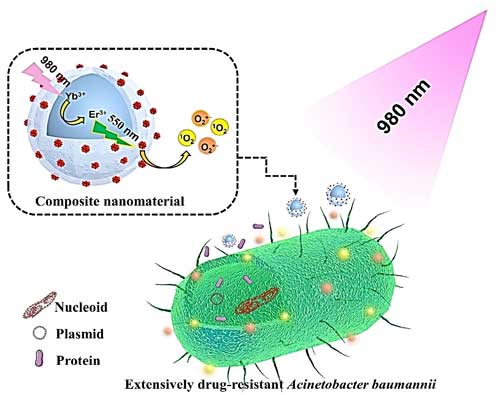| May 15, 2020 | |
Efficient NIR-triggered nanocomposite developed for killing extensively drug-resistant Acinetobacter Baumannii(Nanowerk News) Acinetobacter baumannii (AB) is a type of Gram-negative pathogen, which has attracted considerable concerns due to its inherent drug resistance gene and strong ability to develop new drug resistance. There is a critical need for new pathways to develop antibacterial agents to treat life-threatening infections caused by drug-resistant AB. |
|
| In a study published in Nanoscale ("Near-infrared-excited upconversion photodynamic therapy of extensively drug-resistant Acinetobacter baumannii based on lanthanide nanoparticles"), a research group led by Prof. CHEN Zhuo from Fujian Institute of Research on the Structure of Matter (FJIRSM) of the Chinese Academy of Sciences reported an efficient near-infrared-triggered (NIR-triggered) composite nanomaterial with promising photodynamic killing efficacy of extensively drug-resistant Acinetobacter baumannii (XDR-AB). | |
 |
|
| Schematic diagram of efficient near-infrared-triggered photodynamic killing of extensively drug-resistant Acinetobacter baumannii. (Image: Prof. CHEN’s Group) | |
| The researchers found that the composite nanomaterial consisting of a photosensitizer (Rose Bengal, RB) and lanthanide-doped upconversion nanoparticles (UCNPs, LiYF4:Yb/Er) can accumulate on the surface of XDR-AB and produce reactive oxygen species (ROS) such as singlet oxygen under the excitation of NIR. ROS can destroy the integrity of the bacterial cell membrane, leading to leakage of bacterial content and eventually death of XDR-AB. | |
| The in vitro antibacterial experiments revealed that this composite nanomaterial has a high anti-infectious activity against XDR-AB by 4.72 log10 at a dose of 50 µg/mL under 1 W/cm2 980 nm light exposure. | |
| Besides, in vivo antibacterial experiments were carried out using an XDR-AB infection murine model in the presence of 5 mm thick tissue specimens, demonstrating the great potential of this composite nanomaterial against XDR-AB infections in deep tissue. | |
| This study sheds light on developing new antibacterial agents which are urgently needed to limit bacterial resistance. |
| Source: Chinese Academy of Sciences | |
|
Subscribe to a free copy of one of our daily Nanowerk Newsletter Email Digests with a compilation of all of the day's news. |
